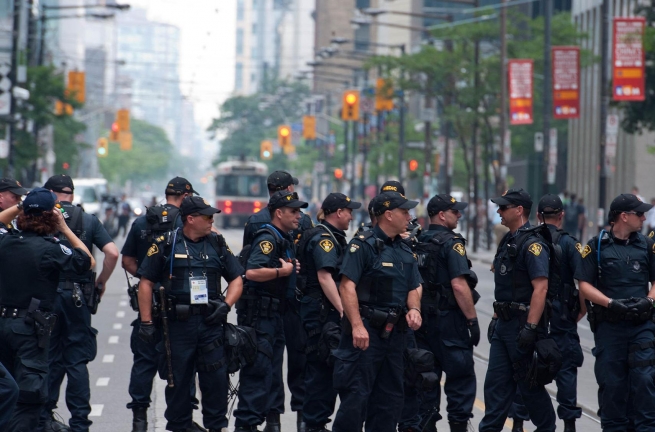
“Down with capitalism, up with socialism!” This distorted-megaphone message is heard against a backdrop of African drumming, French resistance songs, and the constant whirr of helicopters overhead. The rally organizers direct the crowd, “Please walk slowly and peacefully out of the park and west toward City Hall, where we will start our speeches.” It is June 26, 2010 and the People First March in protest of Toronto’s G20 meetings has begun.
Equal to the anger in the sounds of protests is the excitement and fear heard in the verbal exchanges. Accompanying the protestors and officials is a real and sometimes imagined us-and-them mentality. A request from police that a protestor leave her banner-bearing stick at the park entrance leads to vocal objections by the crowd, raised voices on both sides, and police seizing the stick by force. For many in attendance this is all heard through the filter of earplugs worn in protection against the real threat of hearing damage. Two weeks before the arrival of the G20 it was announced that the integrated security unit charged with enforcing the law during the meetings would have access to a sonic cannon for use in dispersing the gathered public. With the power of 150 decibels, this weapon can cause permanent hearing loss in as little as five seconds; a fact that didn’t go unnoticed by the Canadian Civil Liberties Association, which sought and failed to bring an injunction against its use on the grounds that the weapon is untested and illegal.
The varied rallying cries and protests are familiar and novel at the same time. Toronto is not known for its public protesting, but the multiplicity of protesting voices mirrors Toronto’s localized soundscapes. Known for its multicultural population and distinct neighbourhoods, the soundscape of Toronto is pluralist by nature, changing by neighbourhood: Punjabi and Bollywood soundtracks in Little India in the East end, Greek along Danforth Avenue, and Cantonese with the sound of streetcars at Spadina and Dundas.
With a population of 2.5 million people, and an underfunded public transportation system, the soundscapes of Toronto are set against and often masked by the ambient hum of cars travelling a beltway of surrounding highways: Highway 401 to the north, the Don Valley Parkway to the east, the Gardiner Expressway to the south, and Highway 427 to the west.
It didn’t always sound this way. The city’s name, Toronto, is derived from the Huron word for fishing weir, because the city is built on a watershed that flows to Lake Ontario. With major rivers to the east and west defining its city limits, and trees that outnumber the inhabitants three to one, one might imagine a city soundscape of water and attendant sounds of the natural world. But, as with many North American cities, civic planning was based on motorized transport, and with the city’s expansion went the sonic balance between natural and man-made sounds.
Ironically, this imbalance is echoed in the staging area of the G20 protests at Toronto’s Allan Gardens. One of the city’s oldest parks, it houses greenhouse-encased botanical gardens and is bounded by four main thoroughfares. No stranger to social gatherings and protest, the park has been witness to resistance for generations. In 1965 five thousand protestors descended on a Canadian Nazi Party rally, resulting in a riot. In 1994 a group of young black men were playing soccer there when police raided and forced them out of the park. The next day, the newly organized Ontario Coalition Against Poverty organized a mass of people to create a human barricade around them while they played soccer, causing the police to stand down. During the summer of 1999 a “safe park” was erected in the park for the homeless in protest of the summer crackdown on squeegee kids and the homeless.
These historic sounds are known to only a few of the protestors present now during the People First March, but the tone of the songs and shouts is the same: anger, indignation, and hope. As the protestors exit the park and start the march west along Carlton Street, the street is lined on both sides by a solid phalanx of police walking their bicycles, intermittently ringing their electronic bike bells. What emerges is an odd G20 concerto grosso; a piece that has an encore the following day on June 27 when the police and protestor ranks grew and the protest turned violent, resulting in mass arrests.
Three months after the G20, Toronto’s sound identity has returned to its usual varied voice, but the memory of that soundscape persists, and the G20 meetings, which had come to represent for many the economic and social oppression by capitalist corporations, have now become identified, by those of us who listen, with aural oppression and the silencing of free speech.
Image: ©CC BY-SA 2.0 2010 Jeff Denberg.


